Pigmentation Skin Care At A Glance
- Best Results4-10 weeks
- Treatment RecoveryNA
- Procedure Time1-3 min daily
- Skin SpecialistDermal therapist, nurse
- Duration of ResultsVariable
- AnaestheticNA
- Back to WorkNA
- Cost$
Pigmentation Skin Care
Skin care forms the foundation of treating all forms of skin pigmentation including melasma, sun spots, age spots, & freckles. Start off with a good sunscreen, learn how to apply this properly (see hints below), add ascorbic acid, then specific pigment correctors based upon your skin’s sensitivity. Obaji, Murad, Aspect Dr & Medik 8 have good formulations.
FactsFacts on Pigmentation Skin Care
- Start off by learning how to apply sunscreens properly
- Correct amount & frequency are the key steps
- Choose an SPF 50+, La Roche makes great formulations
- Pigmentation takes at least 4 weeks to fade
- The first ingredient is a good vitamin C – ascorbic acid serum
- Consider Aspect Dr, Murad, Obaji & Medik 8
- Other pigment correctors contain licorice root, arbutin, & botanicals
- Skin care acids such as salicylic, citric & lactic acids can help
What is a simple & effective Pigmentation Skin Care routine for treating?
The three most important factors when treating pigmentation are-
1. Sun Protection. This includes sunscreens & sun avoidance. See below for details.
2. Pigment correctors. See below. There are many different skincare ingredients found in pigment creams. Ingredients will vary depending on where you live. Chemicals such as hydroquinone, kojic acid & arbutin are regulated, & each country will have different regulations.
3. Time. This is the most important factor to understand as pigment requires time to shed. Your skin is like a conveyor belt, the deepest cells take 28 days (+/- 7) to make their way to the top. Hence it will take at least 4 weeks before you see pigment improvement with topicals. Exfoliation, either physical or chemical can increase the turnover of skin cells.

This photo was with the first generation Picosure, I wonder what the second generation can do?
.
📸What the photo shows: The possibility of dermal remodeling with this laser, sure pigment is improved, but check out the #collagen stimulation with much less wrinkling (and probable elastosis)
.
🔫How was it done? I really pushed this laser to the max using the Focus setting. I think it was over 3,000 shots with a lot of dwell time with the second treatment. I covered her with tyrosinase inhibitors and short cse CS ointments post treatment
.
😀What is Picosure good for? It is an awesome laser for-
.
👍🏾Ethnic skin rejuvenation with mixed pigmentation, both epidermal and dermal
.
👉🏾Enlarged pores in darker skin types
.
👉🏾Fine wrinkles in darker skin types
.
👊🏽Early macular (flat) PIH / grade 1 #acnescars
.
🎨Green tattoos
.
😎Dr Davin Lim
Dermatologist
Brisbane🇦🇺
.
#cynosure #picosure #picoway #picoplus #picolaser #skinlightening #skinbrightening #melasma #laserskintreatment #ethnicskin #hyperpigmentation
I do love pico lasers, they are great for post inflammatory hyperpigmentation & treating dyschromia in ETHNIC & DARKER Skin types. They are used far too often for treating #melasma, atrophic acne scars & photorejuvenation in lighter skin types
.
📊Data: I suspect the actual satisfaction rate of pico lasers in the context of melasma is much lower than 39.3%, as this data is from my recent algorithmic quiz. It relies on an accurate diagnosis in the first place. I suspect in the context of melasma, it’s probably around the 20-27% depending on variables
.
😀The satisfaction rate may be higher than the efficacy. when pico was applied to acne scarring, the efficacy is extremely low (in the context of volumetric changes), however patients report high satisfaction in other aspects of skin, namely pores & general pigment (including PIH)
.
👊How we employ pico: PIH, resistant forms of #melasma, general dyschromia in darker skin types, Ota, Ito, pore sizing in ethnic skin, early acne scars with little volumetric loss
.
🤓When I still use nano: CALM, melasma, age spots & lentigines in skin type 1- 2 & some 3. Traumatic tattoo (very predictable), drug induced pigmentation (some)
.
😩What pico is NOT great for: Atrophic acne scars, melasma, solar keratosis, one session skin rejuvenation in lighter skin types (fractional laser does a much better job), in fact simple Jessner-TCA will outperform the most expensive pico laser in this context. Any day, any time. Also depends on the company. Enlighten by Cutera has a very long pulse duration, Cynosure Picosure has a good 755 but really dismal 532 & a laughable 1064
.
👉Tips: Based upon this data, you have a higher rate of pico not working for your presumed melama, so think about that. In fact, one in four cases you will be forking out a sh*t load of 💰$ 💰to get worse skin. Roll the dice 🎲🎲
.
.
😎Dr Davin Lim
Dermatologist.
Brisbane🇦🇺
.
#dermatologist #drdavinlim #brisbanedermatologist #picosure #picoway #enlightenpico #picolaser #picotoning #skinlightening #skinbrightening #melasma #melasmatips #melasmasolutions #melasmacure #melasmaskincare #skinbrighteningtips #cosmeticclinicbrisbane #dermatology #skinexpert
Why is sunscreen so vitally important when treating pigmentation?
UV & in some cases, visible light will wosen all forms of pigmentation, regardless of the skin type & cause. Ultraviolet radiation can be attenuated by broad spectrum sunscreens.
The efficacy of sunscreens really depends on your application technique. Concentrate on correct application amount & frequency before worrying about sunscreen ingredients. Guidelines below or @101.skin Instagram.
What sunscreens do I recommend?
Seriously, the most important rate limiting factor is how often & how much sunscreen you use. Find a brand that you like to use. As a guide-
- La Roche Posay: Anthelios range
- Invisible Zinc: Great physical blocker
- Ego Sunscreen: Get for outdoor activities
- Cancer Council: Super affordable, super good
- Neutrogena: makes great sunscreens
- Banana Boat: for outdoor activities
In Australia (due to our regulations), just as long as you get a stand alone sunscreen with a factor of 50 or above 50+ you are protected.
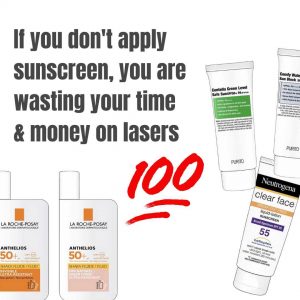
If you have pigment like melasma or post inflammatory hyperpigmentation, you should view sunscreens as adjunctive, in other words your first barrier should be hats, umbrellas & shade.
How do I use sunscreen correctly?
The two most important things to focus on is application amount and frequency.
Amount: Two finger lengths of sunscreen is equal to around 2 to 3 mls. This is the recommended amount for your face, neck and chest. As Caroline Hirons says ‘ take it down to your tits.’
Frequency: Twice a day. Once in the morning, and reapply around midday. This especially applies to patients who have melasma pigmentation.
*If you are a morning walker, you should apply sunscreen before your walk, and reapply again after a shower. If you are undertaking exercise-water sports, you should use waterproof sunscreen. Ego Sunsense, Neutrogena, Cancer Council & Banana Boat make great sunscreens that stick. Invest.


View our Treatment Gallery
What skincare ingredients do I look for when treating pigmentation?
The most common pigment corrector ingredients include-
Ascorbic acid : Vitamin C is a potent antioxidant. It also inhibits tyrosinase, the enzyme that produces pigment. Most formulations range between 10 to 20%.

Hydroquinone: Is the strongest pigment inhibitor. It can not be used long term in strengths greater than 2%. Over the counter in most countries in low concentrations.
Tranexamic acid: One of the best pigment inhibitors as it modulates blood vessels messagening to the melanocyte (pigment cells). Concentrations vary between 1% to 8%, no long term issues with this acid.
Azelaic acid: Is an awesome ingredient that can decrease pigmentation and inflammation, especially useful in treating post inflammatory hyperpigmentation seen in acne. A gel is most stable, creams can be excellent if formulated well. 10 to 20%, use once to twice a day.
Licorice root extract: Organic skin pigment corrector, found in many over the counter pigment correctors.
Retinol: works by increasing the turnover of skin cells (chemical exfoliant), also can reduce activity of tyrosinase, thereby potentially reducing pigment production.
Bearberries: Increasing in popularity, especially organic skin care lines. Antioxidant as well as pigment inhibiting roles.
Botanicals: as above.
Kojic acid: is one of my favourite non-HQ pigment correctors. Concentration of 2% or lower.
Arbutin: Goal posts keep changing in regards to concentration allowed OTC, depending on country. Beta isomer found naturally in berries, alpha lab manufactured. Gets converted to hydroquinone.
Salicylic acid: is a BHA, aids to reduce inflammation & to aid in exfoliation. Commonly found in pigment faders such as Superfade.
Citric & glycolic acid: AHA chemical exfoliants
Cysteamine: Sulphur based pigment inhibitor, super expensive, can be useful in some patients.

How does ascorbic acid work?
Ascorbic acid has many actions in the skin. In the context of pigmentation this water soluble vitamin can-
- Reduce pigmentation production via its inhibitory role on tyrosinase enzyme. This reduces melanin production, and hence pigmentation.
- Antioxidant role in reducing UV induced pigmentation. The effects on immediate pigmentation darkening *UVA is maringal, but it can reduce UVB induced burning. In this context it is more of an antioxidant, reducing free radicals in the skin.
- Stabilizing agent for labile & unstable molecules. I usually incorporate a very small amount of L-ascorbic acid in my pigment correctors, concentration around 1-2.5%. In this context vitamin C acts to stabilise the main compound, namely hydroquinone. This prevents oxidation of unstable molecules.
Ascorbic acid has many other roles in the skin, including collagen production. This stimulates fibroblasts to produce procollagen one and three, increasing the dermal matrix.

Vitamin C also inhibits breakdown of collagen, elastin & hyaluronic acid via its role in modulating matrix metalloproteinases.
The downside about vitamin C is the stability of the compound. A low pH environment of 2.5 to 3.5 is optimal for bioactivity & stability. This means that the most active compounds are somewhat acidic, which may lead to skin irritation. Formulations ranging from 10-20% are best. As always, formulations matter.
Simple concepts & combinations with vitamin C
.
🍑How I prescribe ascorbic acid
.
👍🏻As an antioxidant in the am, in combination with tocopherol & ferulic in patient who can tolerate it
.
👉As a standalone 15-20% L ascorbic acid in the am with a pigment corrector in the pm
.
👍🏻👉In combination with retinoids (in low concentration) in patients who can tolerate this pm routine
.
🧪As an antioxidant (sacrificial molecule, 0.5 to 2%) in combination with potentially unstable compounds; eg. hydroquinone
.
😎Dr Davin Lim
Dermatologist
Brisbane🇦🇺
.
#dermatology #drdavinlim #davinlim #brisbanedermatologist #skincare #skincaretips
#skincarescience #skin #vitaminc #ascorbicacid #skincareroutine #skinfacts #antioxidants #skinroutine #dermalscience #simpleskincare
Probably the only fluffy group of topicals readily prescribed by myself during the hydroquinone off phase😁
.
🔬Skin Science: This ‘organic’ group of topicals can inhibit pigmentation production, hence its use for treating melasma & post inflammatory #hyperpigmentation. Though not as effective as #hydroquinone, they are useful during the off phase of HQ, ensuring that HQ safety is maintained (reducing the chances of ochronosis & tachyphylaxis). These usual suspects are also used for patients who perceive that ‘organic’ is good
.
👍🏻Other ingredients: Citric acid, lactic acid, kojic acid, azelaic acid. There is new product coming out with topical #cysteamine in a mask formulation in the upcoming months 💯
😎Davin Lim
Dermatologist
Brisbane
AU🇦🇺
.
#lskintightening #skinlightening #skinbrightening #brisbanedermatologist #dermatology #skinscience #arbutin #organicskincare #ascorbicacid #melasmatreatment #cysteamine #melasmaskincare #kojicacid
The biggest gains you will get with Melasma & pigment is with strict photo-protection💯
.
🔬Skin Science: Melasma has an action spectrum in the UVB, UVA, blue, HEV & IR spectrum. Don’t get too caught up in the blue & HEV, worry about UVB & UVA first. The probability is that your photo-protection in these wavelengths are not optimised, so don’t stress about micro physical & iron oxide sunscreens. Tinted SPF with UVB/A photo-protection >50 will also cover visible light
.
👉How to use? Two rule. Two finger lengths of SPF >50 twice a day regardless of sun exposure. If you can see light, it’s reflected light. Two types of sunscreen, daily & activity
.
🤗Next level: my team will then take it from there with pigment inhibitors, correctors, modifiers, peels & lasers. We can go so much faster when photo-protection is down pat
.
😎Davin Lim | Dermatologist
Brisbane🇦🇺
@theformulated @cutis.dermatology
.
#melasma #melasmatreatment #sunscreens #dermatologistbrisbane #skinscience #skincaretips
Skin lightening & brightening can be achieved with topicals. Here are some of my favourite over the counter agents🛒
.
🌤Sunscreens: Prevention is 90% of this game. Favs? la roche posay, invisible zinc , melan130 from mesoestetic
.
👍🏻Retinol works by increasing cell turnover, think of it a chemical exfoliant. Retinoids can also reduce pigment production in the skinRefer to previous posts for application guidelines
.
. 🍊Ascorbic acid or vitamin C is both an antioxidant & a skin lightener . It works by decreasing pigment output by the pigment cells in skin (melanocytes). The best form of #vitaminC is known as L-Ascorbic Acid, concentrations ranging from 10-20%.
.
🍏Arbutin is an organic skin lightening agent, however in the majority of cases it is made in the lab; namely alpha #arbutin. Arbutin works by decreasing the activity of melanocytes.
.
🍋Glycolic Acid: Works as an exfoliant. Other skincare acids include lactic acid and salicylic acid. My hand picked recommendations are available through @theformulated
.
🎬Action: Most forms of #pigmentation can be improved with topicals, chemical peels, & gentle laser treatments such as dermal toning, fraxel & pico lasers. Book for a free consultation with my talented dermal therapists & nurses @cliniccutis @theformulated
.
😎Davin’s Pro Rip: Sunscreen forms the basis of pigment prevention. At least twice a day. Majority of light pigmentation can be faded with correct over the counter preparations. The most important factor in treating pigmentation is to have a diagnosis. Some forms of pigmentation such as #melasma require specialist management, whilst freckles & sun spots are easier to treat.
.
.
Dr Davin Lim,
Dermatologist AUS 🇦🇺
@cliniccutis @theformulated
•
•
•
•
#theformulated #cutisclinic #brisbaneskinclinic #brisbanedermatologist #skincare #skincarecommunity #skintips #pigmentation #skinsolutions #skinhelp #pigmentcorrector #dermatologist
Antioxidants have an important role in #skincare
.
😃Skin Care & Free Radicals: Free radicals are primarily caused by UV exposure & pollution. Free radicals have the potential to damage DNA & cell walls, break down #collagen, & even cause #skincancer
.
🔬Skin Science: Your immune system has a very good way of clearing free radicals. The good guys include melanin, #ascorbicacid, tocopherol, coenzymes & others. The role of #antioxidants are to mop up free radicals allowing skin to repair. Antioxidants can prevent #sunburn, decrease #pigmentation, protect against skin cancer, & reduce #photoaging. The following 3 antioxidants listed below can be incorporated into a AM skincare regimen
.
🍊Vitamin C is one of the favs amongst #dermatologists. Vit C can also reduce pigmentation,increase collagen & stabilise molecules. Brands? #Obagi, AspectDr, #Medik8
.
💊Vitamin E is often combined with #ferulicacid, this combination can reduce inflammation, accelerate skin healing and mop up DNA damaging free radicals. Very low irritant potential, many brands. Super affordable
.
🌱Ferulic Acid is a natural antioxidant found in plants. Best formulated in a serum or liquid form. Much like other antioxidants it is both temperature & light labile. Like ascorbic acid, ferulic can cause skin irritation in patients with #sensitiveskin. As always test patch & start slowly. #CEFerulic by Skinceuticals is one of the better ones, but $$
.
.
👍🏻Davin’s Protip: Get your ABCs & #sunscreen correct before adding more stuff to your skincare routine
.
Dr Davin Lim @101.skin
Brisbane, 🇦🇺
.
#skincarecommunity#healthyskin#skincareroutine#beautytips#skincaretips#instaskincare#beautyscience #antioxidants #bestskincare #drdavinlim #ferulicacid #brisbanedermatologist
Can skin acids help reduce pigmentation?
Yes, most formulations will have skin care acids in very low concentrations. This includes BHA/beta hydroxy acid such as salicylic acid (1-2%) & or AHAs or alpha hydroxy acids such as glycolic, citric, malic, mandelic or lactic acid.
These acids work as a chemical exfoliant. This increases the turnover of skin cells, in turn shedding pigment from the skin. Additionally they improve light reflectance & hence optical properties of skin.
Can antioxidants reduce pigment?
Yes, antioxidants such as ferulic acid, ascorbic acid, tocopherol, green tea, isoflavones, resveratrol, & coenzyme Q 10 can reduce free radical damage caused by environmental stressors including UV & pollution.
In the context of pigment reduction they can give a marginal improvement, (most activity with ascorbic acid as it has dual roles). You are better off with dedicated pigment correctors.
How long before I see results?
This depends on the cause of pigmentation & the active ingredients. As a guide-
- AHAs such as glycolic acid, lactic acid: 4-6 weeks
- Azelaic acid: 6+ weeks
- Retinol: 6- 8 weeks
- Vitamin C / Ascorbic acid: 4 to 6 weeks.
- Hydroquinone: 3-4 weeks
For post-inflammatory hyperpigmentation & dermal pigment, it could take as long as 3 to 4 months to notice results.
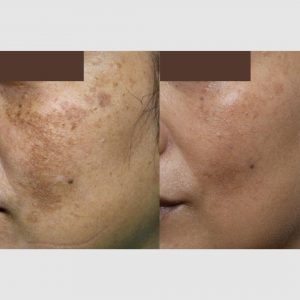
Melasma hyperpigmentation is another stubborn form of facial pigmentation. This often requires prescription medications, coupled with tablets & lasers. Triple therapy can fade pigment over a period of 10 to 14 weeks.
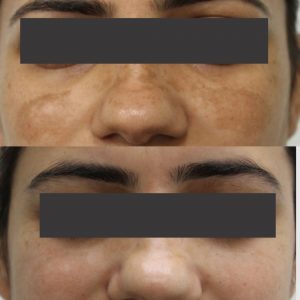
What is melasma pigmentation?
Melasma is a special type of pigmentation caused by light radiation (this includes UV, visible light & IR or infrared/heat). Hormones can increase pigmentation production by cells called melanocytes.
Unlike other forms of pigmentation, melasma does not like high powered lasers (such as Fraxel or IPL/BBL). High density lasers or light devices often worsen this condition. If you are serious about treating melasma, talk to your dermatologist for effective treatment options.


As a guide, we prescribe strong pigment correctors, tablets that modify blood vessel input & low power lasers (nano & pico, low energy settings). For more on how to treat melasma, visit the relevant pages on this website, or my Instagram account @101.skin

Why is pigmentation in Asian & darker skin types so difficult to treat?
Asian or ethnic pigmentation is usually a mix of many types of pigmentation, including Hori nevus, dermal pigmentation, melasma, as well as sun spots & age spots (known as lentigo). Pigment lies in different depths, hence most patients will require 2 to 3 different types & wavelengths of lasers, depending on the exact diagnosis.
Another important factor is that ethnic skin is more prone to paradoxical pigmentation, this is known as Post – Inflammatory – Hyperpigmentation. This means pigmentation can worsen after therapy. On this basis we use special lasers called pico laser to treat pigment in darker skin types.
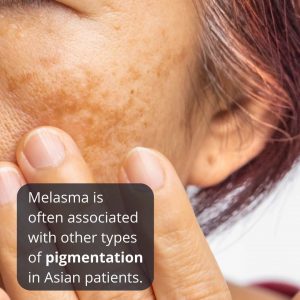
Useful skincare ingredients are very similar as treating lighter counterparts, however, the lasers I employ are very different. For more information on how I approach pigmentation in darker skin types, visit the relevant pages on this website, or my IG account @101.skin
How do I approach skin pigmentation?
Pigmentation, treated at a specialist level is approached with a diagnosis. There are over 150 causes of pigment, ranging from sun induced, hormonal, drugs, genetics & iatrogenic (post procedure).
Regardless of the cause, the initial steps are the same. This means correct use of sunscreen (both application amount & frequency). Pigment correctors include arbutin, ascorbic acid, kojic acid, AHAs, retinol, niacinamide & botanicals.
My go to brand names include; Skinceuticals, Synergy, Obaji, The Formulated, Aspect Dr, & Medik 8. Sunscreens include La Roche Posay & Melan 130.
Can chemical peels help?
Peels can reduce pigmentation & can be very effective, especially in treating sun induced pigmentation & freckles. As a guide-
AHA peels: great for sun spots, age spots, general pigmentation reduction.
TCA peels: great for freckles, & stubborn spots.
Dermamelan & Cosmelan peel: great for melasma (epidermal).

It is advisable to incorporate pigment inhibitors post peeling to help maintain results. Be guided by your dermatologist.

What is the best laser for skin pigmentation?
Lasers are adjunctive treatments. The most frequently employed include nano Spectra lasers, Pico lasers, Thulium & Diode 1927, fractional small spot short pulse duration lasers as well as ablative resurfacing. It all comes down to the diagnosis.
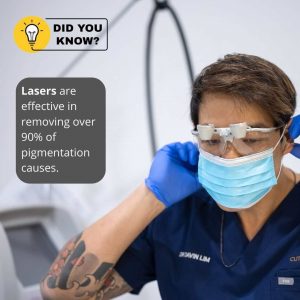
Davin’s Viewpoint: Skincare for Pigmentation Problems
Anti-pigment creams and pigment correctors are the hardest topicals to get right as it depends on legislation, depending where the product is sold. Classically the three main ingredients ( coincidentally the three best ingredients), hydroquinone, arbutin & kojic acid, have restrictions depending on country of origin. Even within Australia, the regulations with concentrations frequently change- arbutin restrictions relaxed in early 2021.
The use of sunscreens can not be over stressed. Up to 50% of pigmentation will resolve with proper use of sunscreens alone. Before you buy anything, get your SPF application down pat. The rate limiting factor is the proper use of sunscreen. If you are trying to correct pigmentation, SPF in your makeup is not enough. You must use standalone sunscreens twice a day. Each application should be 2 finger lengths or 2-3 mls to cover face, neck, chest. ‘Take it down to the tits…’ as Caroline Hirons says. Proper use of SPF means you will go through one (50ml) bottle every 2 to 3 weeks. On this basis find a solution that suits your skin, lifestyle and budget. La Roche makes good & affordable formulations.

From there, you can use specific pigment correctors. My advice? Start with a good tactile, low irritant, non gritty formulation of ascorbic acid. Not Deciem The Ordinary range of vitamin C. They make good wash off products like squalene cleanser, skin acid washes, but their A, B, C formulations in the context of what is out there, is not that great. Suggested brands include Medik 8, Obaji, Aspect Dr & Murad. The latter is good if you have sensitive skin.
If you do not have any skin irritation & you have optimised your sunscreen & vitamin C application, you can add azelaic acid- 10-20% & or Niacinamide.
The other pigment inhibitors, namely arbutin, licorice root, kojic acid, botanicals can be considered down the line. Remember the diagnosis is the most important factor in treating pigment, you may consider seeing a dermatologist for management.


